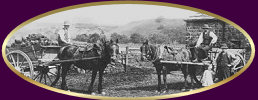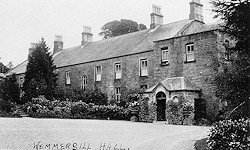

Wemmergill Hall and Grouse Shooting

Lunedale, the playground of the rich and famous. Wemmergill, until 2006 one of the estates of the Strathmore family, has always had a good reputation as a grouse moor.
Its heyday was, arguably, in the late 19th Century when huge numbers of birds were shot and members of the Royal Families of Europe, including of course our own, and MPs were regular visitors during the shooting season, staying at Wemmergill Hall (demolished in the 1980's). Sir Fredrick Milbank MP leased the shooting in the late 1860's when the landowner John Bowes, founder of the Bowes Museum, was living in Paris.
The Hall at Wemmergill had a carbide gas plant and electricity wasn't brought to Wemmergill until 1963 when Sir Joseph Nickerson paid for the supply to be continued from Thringarth.
From 1952 until 1989 Sir Joseph Nickerson leased the shooting of Wemmergill and Holwick. John Grave was his Head Keeper from 1963 to 1980 followed by Peter Fawcett until 1989. In 1990 Sir Tom Gowie took the lease for 14 years and then it was leased by Michael Cannon who proceeded to buy the estate including the farms in 2006, the first time Wemmergill had had a new owner for almost 450 years.
Sir Joseph, one of the longest lessees, wrote in his book 'A Shooting Man's Greed', Sidgwick &Jackson Ltd, (Chapter 11- Grouse Moors- a Heritage in our Trust): "From 1952 I had the shooting on the 17,000 splendid acres of Wemmergill moor, in Teesdale, which belong to the Strathmores, and invested in it heavily because, though I could not buy the moor, I had a long lease on it. Wemmergill has been famous over many years.
"One area of the moor, the Shipka Pass, provides perhaps the best grouse drives in the world. It is a wide, deep ghyll with a stream running through it and, with careful planning, it is possible to enjoy four marvellous drives without moving out of it - all testing birds, especially on a windy day. It is best with a south-south west wind. It still houses The Kaiser's Butt where, before the First World War, Kaiser Bill stood when he was a guest of Lord Lonsdale, the Yellow Earl, so-called because of the colour of his carriages.
"In the twenty years before I took over Wemmergill not a yard of burning or draining had been done. I introduced carefully controlled burning to ensure a regular supply of young heather and put in thousands of miles of drains. The result was an improvement in the grouse population and in the bags.
"Wemmergill does not recover from a poor grouse year as quickly as some other moors; the rainfall is much higher, but in a season when everything goes right Wemmergill has a greater power of producing grouse than any moor I know."
Click Here to view all images relating to Wemmergill and Grouse Shooting.
